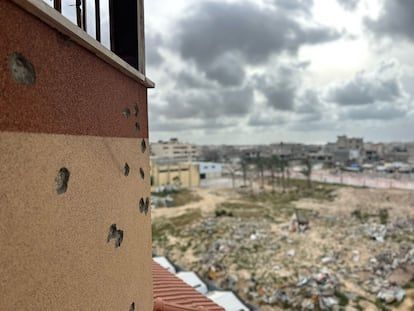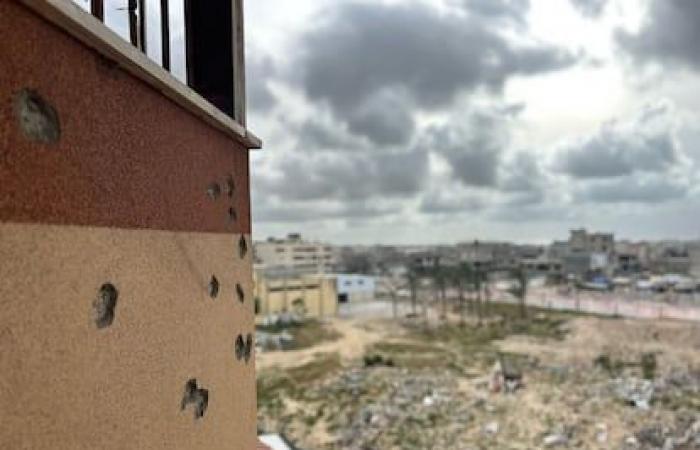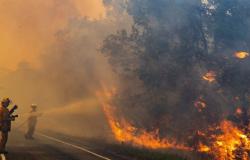The hospital Al Ahli is part since this Sunday of the long list of medical centers of Gaza whose invasion or bombard Sanitary Of the 36 hospitals of Gaza, practically all are damaged or have some part destroyed. Little less than half operates partially, converted into a kind of campaign centers that do not stop receiving injured, virtually without specialty services and making caravals over their stocksby the decision of the Government of Benjamín Netanyahu on March 2 to block any entry to Gaza of goods such as food, water and sanitary supplies.
The Israeli military authorities gave the people who were in Al Ahli, in Gaza Capital, 20 minutes to evacuate it. Then they destroyed the emergency department, the laboratory, the X -ray machinery and the pharmacy, arguing – without presenting evidence – that housed “a command and control center used by Hamas.” The missiles did not cause dead, given the previous evacuation, but a child died when he was left without access to the oxygen he needed. It is one of the 40 critical patients who “should not have been moved,” as the WHO general director Adhanom Ghebreyesus stressed on Monday.
Before the invasion it was a small Christian hospital, but ended up becoming the most important operational in northern Gaza. The three largest in the area are not. The greatest and most famous is the Shifa, because Israel placed under its surface an immense Hamas control and control center that never appeared. It was the principle of war. The troops returned in April 2024 and two weeks of fence concluded with massive arrests and black shells instead of buildings. Like the Indonesian in November, which ended up closing two months later, shortly before Netyahu reached a high fire that ended up breaking last month, not to have to end the war. The third, Kamal Adwan, continues to prepare the reopening of some departments, despite the attack on Ahli, as he stressed Monday in a statement. It was assaulted in December by the troops, which have since they have since then imprisoned its director, Husam Abu Safiya.
Most of the 15 partially operational hospitals are in the center and south of the Palestinian enclave. One of them is Nasser, in the city of Jan Yunis, who has just been embedded between two military corridors: Netzarim – who disconnects it from northern Gaza and Israel reoccupied after ending the truce – and the newly created Morag, which separates it from the city of Rafah, from which the Israeli army already occupies half permanent.

There, at the Nasser hospital, there is the Spanish anesthetist Raúl Incertis, as a volunteer of the small Canadian medical NGO Glia, and resorts to a maritime simile to illustrate the situation he lives daily since he arrived last Wednesday: “It’s like shrinking water in a boat full of holes.” Incertis tells how one of the bombing days unleashed twice the alarm of multiple victims. Between 35 and 40 patients arrived. “It is not the first time that I deal with bombing injuries, but here it is many times every day. The ICU is full and is like the house of horrors,” he says by videoconference from the hospital.
Incertis still has means to anesthetize (some children have been operated in Gaza without anesthesia during the war), but worries the shortage of provisions, after a month and a half of Israeli blockade at the entrance of medical material. “To the rhythm we are operating, calculate that in a month we would notice shortcomings,” he says. The center already applies savings protocols: gloves are only replaced when they get dirty, intubation devices are cleaned and when half of a drug is injected into a patient the other is used in whom he needs it, instead of throwing it as usually.
The Ministry of Health of the Hamas Government in Gaza figure exhausted medications by 37% and in 59% medical supplies. Your data show zero stock 60% of those considered essential drugs according to International standards. Among them, 99% of employees for cardiac catheter and open heart operations; 87% for orthopedics, 45% for kidney and hemodialysis, and 42% for emergencies, surgery and intensive care.
Key hospitals departments also depend on electric generators. Israel keeps almost all of the electricity to Gaza since the first days of the war. A month ago, it disconnected the only line that had been re -enchanted (the one that fed the water desalination) in the framework of its strategy to force Hamas to accept its terms applying collective punishments to the whole population.
Systematic dismantling
The WHO representative for the West Bank and Gaza, Rik Peeperkorn – who spends several weeks in Gaza every two months to know the situation on the ground – intervened last January by videoconference before the United Nations Security Council. He said that hospitals in operation had a capacity “very far from what was necessary to deal with the overwhelming crisis situation”: 822 beds. “The Gaza health sector is being systematically dismantled and taken to the limit,” with the hospitals converted “again and again in battlefields.” The majority only provide basic attention for a mixture of “damage, attacks and lack of media,” he added.
A good part of medical care ends up displaced to health centers and the so -called health points, which try to cover the holes as they can. More than half of the 145 of the first and 360 of the seconds do not work already. It is, in a way, as if there were only urgencies, and doctors and nurses attend without ability to derive, because specialized care is practically non -existent.
What in other contexts would be serious, in this (in which queen malnutrition and infectious diseases have shot) can mark the border between life and death. The polio reappeared last August in Gaza after 25 years and was needed an urgent campaign of vaccination. Of the 130 babies that are born daily in Gaza (27% of them by caesarean section), a fifth does it prematurely, with complications or less weight of the desirable, because their mothers could not adequately nourish themselves during pregnancy.

Since Hamas’s attack against Israel in October 2023, Israeli bombings have killed or wounded to 7% (mostly, minors and women) of the more than two million gazaties. The Ministry of Health of Gaza has estimated on Monday the dead in almost 51,000 and the injured, in more than 116,000. A quarter of the last suffers from injuries that will change your life, according to the United Nations.
An alternative would be its medical evacuation, but requires the diminishing permits of the Israeli military authorities. The baby Mustafa Abu Freij, for example, has just arrived in Italy. His family had been waiting for authorization for six months so that he could receive treatment for the gunshot wound he suffered when he had nine days of life. And it is only one of the 4,500 minors (of a total of 12,000 people) who would need urgent medical evacuation, calculates the WHO. The coordinated and medical outputs abroad have been from the beginning of the war below the real needs, but they have stayed in a handful of monthly tens since May 2024, after the Israeli shot of the border pass of Gaza with Egypt. To the current rhythm, Peeperkorn estimated, evacuating those who need it would take five to ten years.
More than a thousand health professionals have died from Israeli attacks during Gaza’s invasion. The way they did 15 last month (on the most lethal day for Palestinian health services) caused outraged outrage. They were killed (some, with indications of execution) in three different attacks against their ambulances; and the soldiers buried their bodies and covered the vehicles. A video recorded by one of the toilets before dying also revealed that the Israeli army lied in its initial version.







